Asus Eee PC 1001P: Our Favorite Netbook
by Vivek Gowri on March 16, 2010 11:30 PM EST- Posted in
- Laptops
Asus Eee PC 1001P: Awesome LCD
Starting with what is arguably the high point of the 1001P, we have our LCD testing results. The Eee 1001P is one of the few consumer systems on the market with a matte, anti-glare screen, and it is truly a revelation in comparison to the overglossed screens on many other systems (Toshiba NB205, I'm looking at you—but there are far more out there like that.).
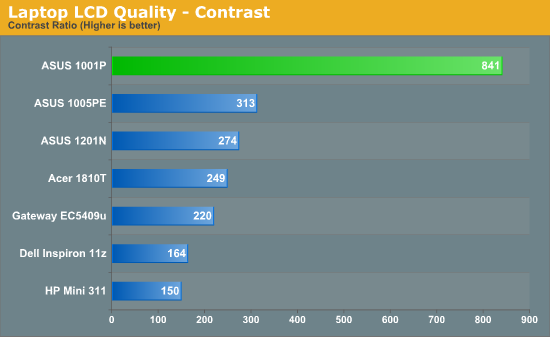
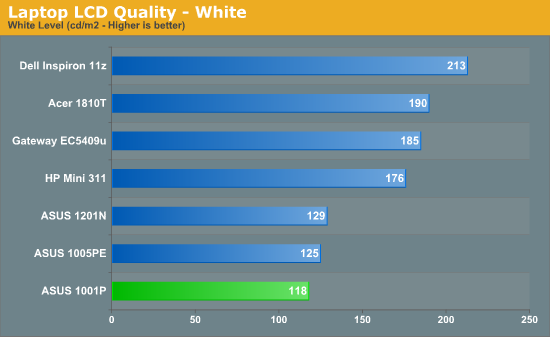
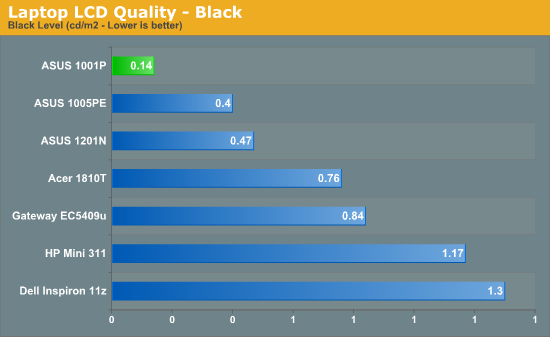
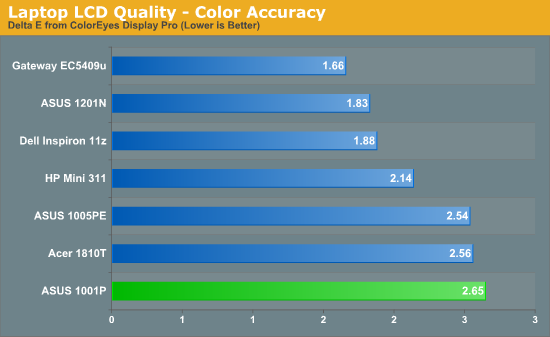
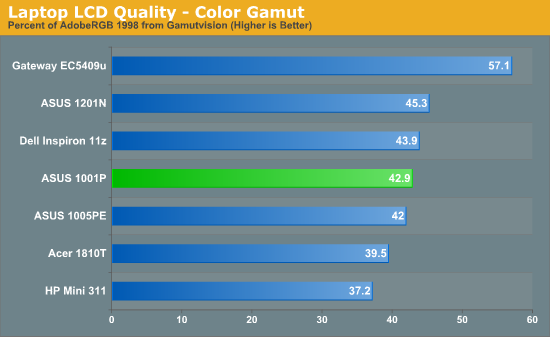

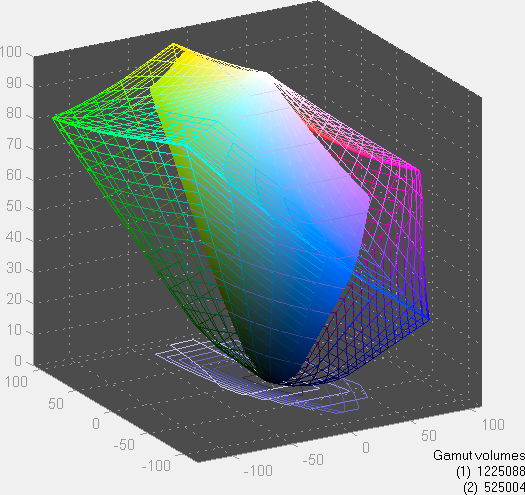
Compared to most other laptop displays, the 1001P has a very high contrast ratio, which is a definite bonus in a budget system such as this one. The black points are much lower than almost all other systems tested, except for the 1005HA. While not as bright as some of the other LED-backlit screens, the 1001P is hardly lacking for brightness, especially with a contrast ratio as good as it has. Interestingly, all of the Asus Eee models have a max brightness of around 125 nits, suggesting that this is an artificial cap set by Asus in the brightness control software, likely for the purpose of conserving battery power. The EeeCTL utility allowed users to increase brightness on previous models like the 1005HA, but sadly development of that tool has halted. Color accuracy and gamut are nothing spectacular, but no one is going to be doing serious video editing or image work on a netbook, so those areas aren't as crucial as the contrast ratio.
In comparison to the 1005PE, the 1001P definitely has a better screen. Asus has assured us that there is only one panel supplier for the 1001P, and other users have reported equally good LCD quality. That is excellent, since the high contrast ratio and non-reflective finish make this one of our favorite netbook displays. Some might prefer a higher resolution, and while we understand that sentiment, 1024x600 on a 10.1" LCD is easier. The .216mm dot pitch is the same as a 14" 1280x1024 LCD, or put another way, if it were a 1366x768 panel, the dot pitch would be a very tiny .164mm—the same as 16" 1080p display. Of course, even if the dot pitch is about right, there's no getting around the fact that 600vertical pixel displays feel very cramped within Windows.










63 Comments
View All Comments
mczak - Wednesday, March 17, 2010 - link
Conclusion says the only thing you give up over 1005pe is battery life. I think in this time and age, not having n-wireless is a fairly big omission too. Maybe not quite a deal breaker, but I'd consider that an important distinction between the two (maybe even more so than the battery life difference).I'm wondering though if we'll see most netbooks switch to the N470. Not exactly a performance demon neither, but every little bit helps...
ric3r - Wednesday, March 17, 2010 - link
It's purely a cost thing, and honestly, so many public hotspots are still on g (or b) wireless that it's not really a necessity to have -n wireless. Yeah, it's nice to have, but not essential.As for the N470, yeah, we'll see. I haven't noticed any difference speed-wise between the N270, 280, and 450, but the N470 does offer a comparatively substantial speed bump so maybe it'll do better.
heulenwolf - Wednesday, March 17, 2010 - link
Agree, I'm tired of the G-only devices holding up my N-network at home. Even the Nexus One found a way to put N-networking in the device. I guess it comes down to cost, though. A part costing $x more on an unsubsidized device tends to lead to a retail price $3x more. I don't think the mass market wants a netbook when the price creeps near $400. So, perhaps the G-only networking was a cost-cutting measure to keep the price well out of the range where people could even round up to $400.mucker365 - Wednesday, March 17, 2010 - link
> I'm tired of the G-only devices holding up my N-network at homeHolding up, how? Do you have an internet connection with better throughput or latency than wifi g?
Veerappan - Thursday, March 18, 2010 - link
He could be referring to inter-computer transfers, such as streaming videos off of a NAS via wireless. I've had issues in the past with collisions on a 802.11G network impacting playback performance of HD video streamed from another computer on the network.I'd also love to do a NAS setup with my Linux boxes where there is a network-mounted home directory, but as it is the wireless speed of 54mbit/s (when I'm lucky, more often it's in the 30mbit range) makes that impractical.
It's also very possible that he is being held back by his router in his network speed. My FiOS connection at home has been clocked by DSL Reports at 25mbit/s down and 18.5mbit/s up (this has been echoed by real-world transfer speeds). Add those upload/download figures together, add in collision reset times, and 54Mbit/s could actually be a limiting factor.
Shadowmaster625 - Wednesday, March 17, 2010 - link
I had the chance to play with a netbook with the same specs as this. I was impressed until I put it in sleep mode. I put my ear up to the vent and noticed that the fan was still running. It never shut off. I tried waking it up but it never came back on. Apparently during the process of closing the netbook lid (which puts it to sleep), I must have caused a hard drive I/O error which locked up the netbook. So it never suspended and the fan never shut off.What a joke. It had to be the hard drive. The hard drives in these things are nothing more than cheap garbage. You know it, I know it, everybody knows it. Anandtech ought to be ashamed of themselves for recommending such garbage. Even the smallest, crappiest SSD is better than crap that breaks on a dime. I dont care what any of these morons say, do NOT trust a netbook hard drive any further than you can throw it.
strikeback03 - Friday, March 19, 2010 - link
So you write off the entire category because one example of one design had an issue?JonB - Wednesday, March 17, 2010 - link
You would think a nice, solid state hard drive would be problem free, but it sure wasn't for me. I have replaced the failed 8GB Intel SSD with a cheaper and faster 16GB SuperTalent. This was an Acer AspireOne, though, not the Asus series.When an SSD fails, apparently it just goes away. No warning, no chance of recovery.
Hard drives, even cheap hard drives, usually give some warning.
mckirkus - Wednesday, March 17, 2010 - link
I wasn't aware that Intel made 8GB SSDs. The new generation are around $100, 5x larger, and are rock solid. In fact, some say they're better at dealing with failures than the rotating variety.I'd rather have a super fast 40GB SSD in one of these things than a 250GB spinning disaster waiting to happen.
8 & 16 GB SSDs are really old tech.
JonB - Wednesday, March 17, 2010 - link
Both the 8GB and 16GB SSDs are literally the size of a credit card and barely thicker. A short ZIF ribbon cable connection to the motherboard.My AspireOne is running a slightly modified Linpus so needs very little room and I store everything of value on SD cards. My netbook is not a desktop replacement in any way; more like a huge smartphone.